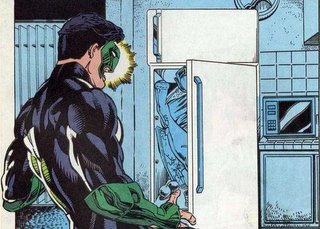Girl·friend-in-re·frig·er·at·or Syn·drome (gərlfrĕnd-ĭn-rĭ-frĭj'ə-rātər-sĭn'drōm')noun1. A condition afflicting comic-book writers (sometimes extended to writers in other media). Characterised by a tendency to inflict death, rape, or other forms of gruesome torture on female characters, with the sole aim of improving the characterisation of related male characters.
This term was coined by the incredibly talented Gail Simone - arguably one of the best comic book writers in the industry today (
Superman, Villains United and the brilliant
Birds of Prey as well as stints on
Action Comics and
Teen Titans), and definitely the top woman in the profession.

Being one of very few women in an industry where men create stories about male characters for a male market, Simone was able to observe firsthand the overwhelming misogyny present in a boys' club where she was part of a tiny minority.
Of course, this is an era of equality and political correctness, so overt displays of sexism are impossible. However, Simone did notice a disturbing trend. A surprisingly large number of female characters - mainly in supporting roles - ended up dead, dismembered, tortured or brainwashed for little to no good reason. Usually, these incidents were used by authors to better flesh out the character of the men in their lives. Often such incidents would lead to an immediate surge in sales, thanks to fans whose immediate reaction was "Oh my God, I can't believe they killed so-and-so". They also allow the writer to take the easy way out by writing a whole series of issues in which the hero sits around and broods, considers giving up superheroing, but finally decides to come back. The incident also provides plenty of material for later issues, where the hero can remember it and start to angst.
Simone and some friends set up a
website where they chronicled such incidents, and get feedback from other comic book writers (respondents include Warren Ellis, Mark Millar, John Byrne and Marv Wolfman among others). The website was named- "Women in Refrigerators", in reference to one of the most prominent such cases, from
Green Lantern #54, in which the new Green Lantern, Kyle Rayner, comes home to find his girlfriend murdered and stuffed in the fridge by homicidal maniac Major Force. This was seen as a quick-fix way to add depth to the character who was already unpopular with fans just two issues after his introduction.

This particular case stood out for its sheer brutality, but it was by no means the first case. The credit for that goes to the now celebrated death of Gwen Stacy, Spiderman's girlfriend in Amazing Spider-Man #121.

In the now-classic sequence, Stacy is pushed off the Brooklyn Bridge by the Green Goblin (a similar scene was shown in the movie). She is caught by Spiderman, but when he pulls her up, she is already dead. This scene has been dissected for years by comic-book fans everywhere.
There have been many other notable cases. Green Lanterns are among the worst sufferers - Hal Jordan's girlfriend Carol Ferris was turned into his arch-enemy Star Sapphire and John Stewart's wife Katma Tui, herself an accomplished Lantern and a character with plenty of potential, was killed by Star Sapphire. Kyle was at the receiving end again - two more of his girlfriends have died and though the death of Donna Troy doesn't really fall into this category (her relationship with him is almost completely forgotten), the recent death of Jade was the trigger that transformed him into the godlike Ion. Clearly in the refrigerator.
Over at Marvel, Bruce Banner's wife, Betty died of radiation poisoning from being too close to him - leading to huge amounts of guilt for the already angst-ridden Hulk. Daredevil has lost two girlfriends to this syndrome - Karen Page and Elektra. The first was even turned into a junkie and used in a porn film before being killed, compounding the misery. I will be running a regular column focusing on each of these cases.
DC's big event of 2004, Identity Crisis, brought the website back into the limelight, because its main plot was the murder and retroactive rape of Sue Dibny, wife of the Elongated Man. Once again it seems that big suggest sugest hard times for comicbook women.
Some people have contended that this is an exaggeration - the deaths of Jason Todd, Bucky and Uncle Ben being examples of notable deaths of male characters. The difference here is, however, that in all these cases, the characters who were affected by these deaths were all male. Also the sheer number of women who die pointlessly is much, much higher than the number of men.
My own take on the matter is that while the Girlfriend-in-Refrigerator Syndrome may or may not be a case of misogyny in the industry, it is certainly indicative of another serious problem - unimaginative writing.







